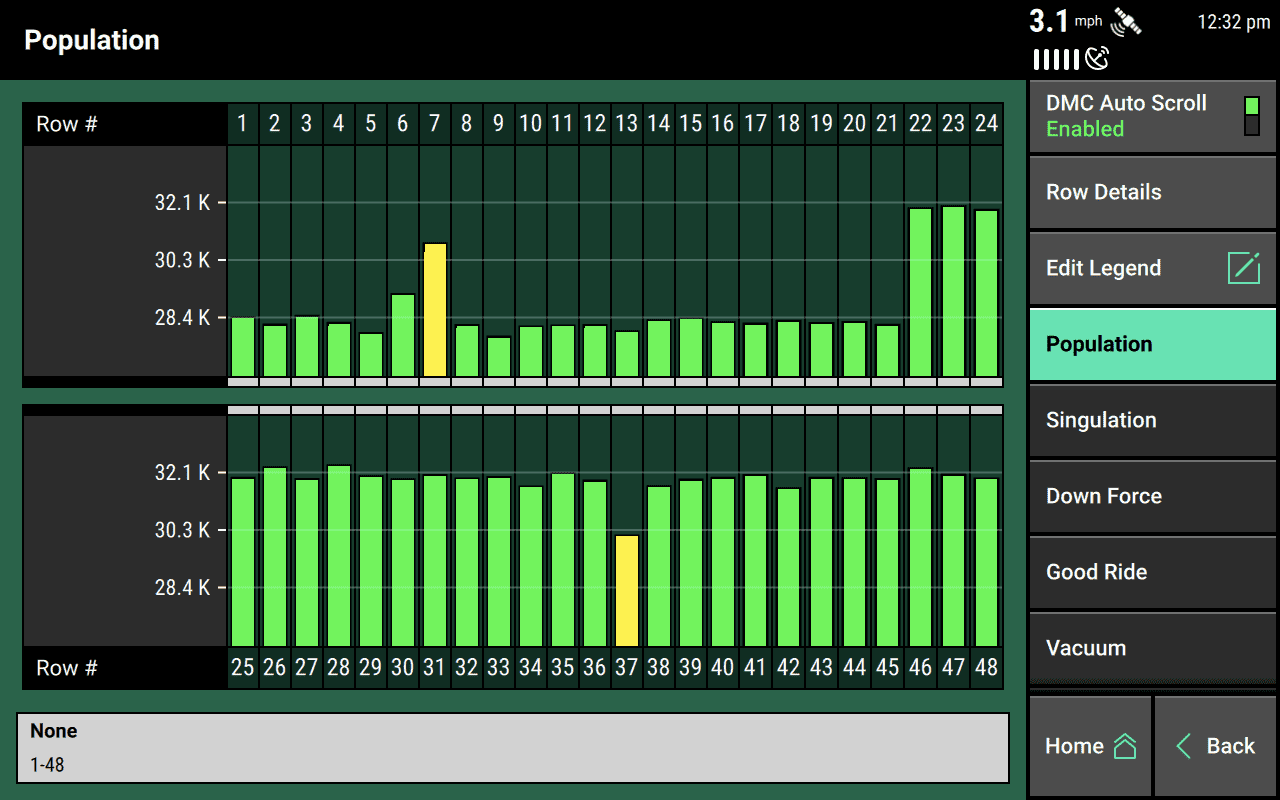Alerts
Get to know the 20|20's Alerts setup menu.
Updated February 17, 2023
After you have added a system under the Systems setup menu, you can go to the Alerts setup menu to tell the 20|20 how you expect that system to perform: what counts as operating smoothly, what counts as failing, and what you'd like to see when something fails.
To give you greater flexibility, the 20|20 saves these settings on a per-crop basis. So when you switch from, say, corn to soybeans, the settings for all systems will also change to how they were the last time you were planting soybeans. Accordingly, you should make sure you have set the correct crop in the Products setup menu before proceeding.
Table of Contents
Find the Alerts Setup Menu
As its name implies, the Alerts setup menu is accessible from the main Setup menu, which you can reach from anywhere by tapping Home (if you're not already on the home screen) and then Setup.
Once on the Setup page, tap on the Alerts button in the sidebar.
Understand the Alerts Sidebar and Navigation
As with other setup menus, the Alerts menu is organized by system, and you should see all of your configured systems listed in the sidebar. If you don't see a system that you were expecting, you need to go to Systems to add it.

When you change any system's settings in the Alerts setup menu, a Restore Default button appears at the bottom of the sidebar. Tap on this to restore the default settings for the system page you're currently on. It will not alter the settings on other pages or systems.
Change System-Level Settings
Set How Many Seeds to Use In Calculating Averages
When the 20|20 shows you a seeding metric, it's actually showing you a running average. And you can change how many seeds are used to calculate that average.
For example, let's say you're looking at a singulation rate of 96.5%. You might wonder, 96.7% out of what? the last thirty seconds? the last one hundred seeds? The answer is the value shown in the Seeds to Average field on the Crop setup page. If you have that set to 300, then that means that 96.7% of the last 300 seeds were properly singulated.
The lower the value you set here, the more responsive your averages will be to fluctuations in performance. That's good. But it's also possible to be too responsive, since the 20|20 may alert you about problems that are really just random blips. We recommend that you set this value to about 1% of the current population setting (for example, if you have Population set to 30,000, then 300 is a good Seeds to Average setting).
Select What Happens When a Row Fails
What do you want your 20|20 to show you when a row crosses a failure threshold that you've set? You can change that behavior by tapping Row Fail Action on the Crop setup page. Then select between the following options:
-
Being taken to a bar-chart overview of the implement, where you can see the status of all rows (Jump to Bar Chart)
' width='1280' height='800' xlink:href='data:image/png%3bbase64%2ciVBORw0KGgoAAAANSUhEUgAAAEAAAAAoCAYAAABOzvzpAAAACXBIWXMAAAsTAAALEwEAmpwYAAATX0lEQVRogdWaWZScxXXHBwkrJgaNthlp9p6epfd9md73fZ/pnumeTRpJWAgJEMhabHYh4BA7MQYDYTFgA5IQkkBIAgnJCGMbxwFCQOA48fFx4uTkIclJ3vL8y6nq7tFIQnDsY5%2bYh/%2b59d1/VfVXt%2b6tulVft7S0tPBFxxVXXCHlsEqDyWhgaHCIpdcspae7G6PJdL7eokV0dXXR09NDe1sbS6%2b5hpZFixcTCIZwOp04nQ7cbg/JZBKfz4/NZmXRokVfGAMoB4dRDw/JQbYubWVoaIhisciVV145X6%2bnt5fBgUFUwyraVrXRsnjRYvQ6PaFQlGqlTDwWp5gvEI3ECAcD/%2b%2bD%2b13Q399PPl8gEongcDikIT633RVXLv7MCouWXHkJFl8kL4fFS750QfmPhSu/vES%2bq0qtolQqEQqFMJlMdHR01MewaNG8lyxefCVLlixhyeIldc9Qr00wPB1joBZmaCoqoZ5NoJlNSCm4JiQ/GWFwMlKXok3jWZSlXADRZ70cRlkNoqyGZL2BBsTzQC1Ul03UQgv4oNQJfr6O4Brlhe2UU2F0fifjoxXWrl1LdaLG1OQUMzMzzM7OSt3c3BwTExOkUilyUxl8AS8tqrkkbcN9dA8oWN7ZTntfF1etWMqS1q%2bwpPVqKf9s2dV86eqrWKlR0OU20Oe3zMtOl55er5E%2bn5lOl4Eu8ew30%2b02oAza6PEIzoQ24WU44qQ/YGWwIdUxF4Mhh9QPR10MhR0og3YGhAxY0SW9DAkuMoI%2b5ZNyMOxAFXVJqONu2caQ9tNfCWBPh7l5243ccfcdbN66ma/t2sHOXTvYunUrO3bsYNfOncxMz8g1Lr49gC/qpWV4Ns7yNe2YdEa0ag19Pb1ccZlwuKa7nTU2NQq3iU6bVsouuw7FiIF%2bt5k%2blwml28Rqq0ryqoCDLruWXqceQ8yPOuigx2lgKOBAMWJEF3EzHHCgC7vQhN1ogk50EQ9Kr4UeuxZbOiR5dXAEazqEJjTCkM%2bGNuxCF3aji3pQB504c1EUo17sqSBjW/Lkd6YZuyNPaWeWTC1NKpEimUrKgWezWXK5HHabA4/HQ4tmLkXXgIKO1Wvo6Oygo7OTnt4eent76%2bjrq6O7h1VqBa1mJSusQyw3KVlmUtJq7JcQ5WWN8nLr4DzXlEuNCpYaGrzlPN9q6Ocag6JexyCgYJlloPHc1IvfHTj/O000dK0mJb0lD6aoh1gkQjQZJZqIEE1EiUQjclFciHA4TDQaxW6306KeS6KxGjEbTXLhEDAajRIGgx6NRoNOr0On0cpZWeXRstqnp82tpd2jo90j5Pmy0K/2G%2bb5tgt43YW8t667AJ/CX9yn1HuFTi/77gga6R31Yk34yaezcidLJVMSYtZFzF8M4Qke4QHquRQqkw69VodOdx5ajQarzUY8HsPj9eIZcdFt09Dm0bHGZ5AvWn/hBubLWtb4P5tf7ftd%2bfO61V49K6xqVpjVrHJqWWnTsNKqkwawp0J8fedubrv9NrZvv4Xbbrude/bsYc%2bePZRKRen6%2bXxeSpEf%2bP3%2bpgH06MXA9Xr0DWi1WhwOJ/l8jkAwSDQUot9lYo3fSFfIQofPSKffRKdfyPNlof9D83Wdmc6AiTabDts2N86dboL3%2bbFc72BkhwdF2YstEWCsOEq5UpHb4ejoGOVyWULMeCaTkUhnMuTyebxe76cbQHiAkGq1WiYXIqMaVA7SaVGxYkQt3XrViJpVLk1dLiivdKpZ5dayynl5/vPaX8w3de1eDVcplaR/EKH0SoyxV2PEHvMy87MsiooXY8RDOBDE5/cRDAYJBAISYqZF3DcREhMaDjfXgM/2AOEukWiMsN9Pr0MvXVHMxBqvXobCGm8dHaIs3VTHU097mdhs5Rq7nk5/o858XT0dn9L%2bs/m6rjNopFWjIvVklML%2bOKVDCWIPBZh6My8NYEsGGR%2brSA8QLi68QEB4gPDk5g6Qr5YpzdbwfV4I2O0OstkckUiUkN9Hn1MvF6OmATr8Cwwg4n5Ez0qblo/fT3LDrU6usujo%2bjQDBBcMsIGmARfyHRe1kQZQq0h/L0rxxTijhxPEHg4w/VbDAKkQu3buYs%2b9e9l64w3s2buXu%2b%2b5h9vvvIPKRIVMLkt%2btEhp01rKt2zCHw5%2bdgiIHUCEwODgIEMDg3SYVCy3q2j36aRbrrA33VcsSGp6s3qUFT1/86MIX91pZYlRxWqPRvJt7roU9du8urrOo5H9yL4cdSndXfDC9UcaISDDTqz8Gr4yNEDiyRC5/REKL0UJf8fD5JuZugHCXgrBOJlwjGw4TiGaJB9NynImFJtHNpOhWCrhtY98hgdoNDicTsbGxkimUsRCIYZCJhQ5M6tdYlEyMDgmFivhEUZaVVpC3wozcSrDz8/GuH73CFcZdHT5jKzxGGkX3uM2sNqlZ43XxOoRA212A11Bo4QibZZS9NfhM9HhNdAVMkpZL9f5pYPDpL8Xo3QwydiRJPHvBpl5u0hfYQTfjVNsfOFbzDy1l9mn72X26fvq8qm9zDyxZx7Tj93Fuu/dS/rW6xYY4OJtUKvFZrcTi8cJhoLYNDaie3xUXkvhv89H5Nt%2bqqcz8gX893lRFozEvhum8lqan5wMs%2bthD%2b5vB1Gk9PSl9JJz3%2bEh%2bICP8F8FcewcQbvOSu65GKknQ9TO5Ig/EiT%2baJDgX/hwfcNB/vko3rtcBB/wSs59%2bwju20ZIPxOhsD9G6VCc2EN%2bpt4u0JO0En18F9f%2b9lXW/fIgc786xOy5/bL81X87zpb/OcP1/31aYvN/vcGN//s2lTcfrRtAJEJGgxGjqZ4ASZiM6A0GNFoNeqOewS4Vsft9jJ2JM/GjNLnDYcZOxSmfTpI9FKb6dor0iyGKJ2L89HUfdx30kf9xmuLRKMnnA0y9myX/coTymQTjb6fJHQkzfjbB6KkEmYMhJoTucITSazFGT8aI/LWb8g8TxJ/2yd8qvBoh%2boSH0ZNREj8IkD4Qkn0EH3JR/UlaGiDy0HZm//ZZYo/tJvXMnXU8fQcTpx9hy7%2b/zubfHmPzvx7nun85xg3/8QblEw/WM8HegX4UXT3yHNDXfR6KHoE%2blAoFHUvXkNwRZO6lcdbtH6f2RJF1ByrMPF%2bm%2bniR9YcnqD1ZYub5MV57scidT%2bSo7quwbl%2bF2lMl2U60mXlujLkXJ2R57f4Ks8%2bXZbnZfvrZUWafK1P6Zlry5Qdz1J4oMPP9MUa/lWH6mRITjxaoPVlk5vujst61r07Sn3YQ/MubuPE/T7PpV0e47jdH2fzPr0ps%2bvXLXPvLl7j2l4ckNv7DQcmXDj9Ai2Z9mo6AkfYRNatdWtpdmkuw2q1lhX2I0NwYk7duZfIbW5nYtZnq7uulvLg8desNf3D%2b03S1r2%2bRUryPYX2GAbcZjV7HsF6LyqCVclinQW3UY7BZLoDRYWNQoxIGSLHGNET7cB/tagXtqougVrBa3c/KgW48pQSlLesY3bKO/KYZCptnKVw300C9nN80zejWuUv5zb8//%2bm6GUrXr61zW9ahm02isOlIReMUCwXSyRSFXJ5SoSiTHnGW0YlzjUYrT71izVP299dDYEinRjukQjP8KWjqB4botWrlKt0j0lKxMnsNUsqyr1H26OkJmi/UNes00B0wy3rznGdBXx493cGLef18G9mHr45ukSpLzoSyEkA5YiQVTzI5PS0vQcTlR61WI5tJy/VsHnq9XOcGBgfri6DabMAgtj/DAuj1GAwGDOJUaDRKi3WYVSx3qlluFVDJfXq5TcUKu4rlNjUrGvv5CodG5gvy2V7XtXnrdZeZh%2bWJUuztK0Ve0IB4rrcX7bTzbZp9rnTVdStdGtlHq2mIFU6N/O2VI1p5IaJ06OnvVaDoV8j8RRzn%2b/r6UCqVDA8Py5S%2bCZVKJfkLt0Fx7F2QBLlcbmnBeCJBKh5nQMx%2bzEDomyH0cw7aLBqCD4jtyUd/1kxv3EhXQI9m2oEyZ6Y3ZpJ6RcrESpOO4YoNwwaHzCTlASgg8gG9zA26ggZ6InWoa3b6kiZWGHX0RIxS15c0S7naocV64wj27S4Gi6Jvo%2bSEAYbdFkx6A1qdVr6/ONqL8YiymPHmcV/AYrFIo1w2ERINhQeYzWZMFhMahY7YHj9jx5NM/bhA4WCc0uEE1dNZiofiVM9kyT4XlXuzSIZyL0QZezXJ2NEUmWcjuO/0SDlxMkXhQAzrNietWhWePV48d7kpH6vXKx6MUT6WJHC/B8tNDqIPB8g%2bF5Ftot/xkX%2bhXh59JUHxpSiRB71UT6VRTvgZGDFTyhel61cq4/I8MDFekWcBq8Uic5tmniPGplQqP9sAzVgRBhjuVhO/18/46RTlE2ly%2b6NMvJGWg8y%2bEKF2Nkv%2bQIzyiSTjpzLkD0QZPyXqpmTd2Z8XJC9efOadPI7bPLR0KKm8nqZ0JE7trRyFgzFGjyZkndgjPqZ%2bnCX5ZED2JerEHvUzejRO6pkQ2ecjFA/HiD7kZfKtbMMAJkL%2bAIlkglgshsftkfcZyWQKc8MbmuMTBhgYGLi8AYTbuD0eeataGC0Rc0dJ3h%2bmejpH9VSe4otJqiezjJ/IUjyQYOpsUerGj2eovtHgT%2bUkX9ifYPKHhTp/LEPtrSKJ%2bwK4ozrKr2QoyPZ1vnw0TflohsQjQcZfy5J%2bMiL7HzuSIvlYiPLLKXI/iFM8cD4Vnj6bZ6AaYMBpRDU4xNBwPc4Xxr0Yj/AAAXnLpdPJdeJzPUBYymg2MNStIrbXT%2bVUSs6amNXK6ynGjqfI7YtSezMrdWPHEtIDLsdXjiUonMpw874Q7x33MXEsSabBSw95OS49IPqwV7ZPPB4gv78%2b28IrSkdipJ8Nyz6Lh2JEhAe8mal7gNOEUde4xtPppPcuTO8XQoxN%2bXkhYDAY5aWB1W5F268nfl%2bA8TfSjJ8ULh5j/GSa8vE0%2bX0xamdz9RA4LkIge1m%2bcjxJ8VSWW/aHef%2b1ANXjKbL7Yky%2bKfj64EdfSRJ72M/462mSTwTJ74/K9SYuQuBInMz3I%2bTFWeBwnOhDPibPZhmY8KN0GqmNV9mwYSMbN25g/YaN3HLzzcSiEXm5Iybz8iGgrRtg4S4gvhNOT89QHC0RcYUbIZA9HwKn6iGw0IXHTywMgUv5ieMZSm8U2H4gynuvBZk8IYzV4A82QyAtQ0CE2CUh8IoIgVhDVw%2bBqQUhYDGa5CnWZrNhNlvkN0/hCQtDoLkY9jcToYUecLGbSGuZ9Ax0DhO9x3dpCByru3h1QQhUTl6elyFwsh4C757wXxACObHYvRyn9HJCunYzBHL7ItLdLwyBui7yHS%2b1%2bRAwoh4cZmh4WMa/2OuFvHjwF6wBmoYH6LTaS2K/aQCxBohdIHavj/IbYoApcgcilE8mGDueILsvzMTZNNn9YcaOx6WRBF9ZwFfPputtjsfJn0pxy/4Af3fCw8TxBGnBv1nnS69EKR2NEXnYI9vHH/eR2x%2bmeDhK9BEvxSMRUs8GG7oI4YfcVM%2bmpAEGXWYcFhtWq1Vu31KaTOeTugaau9ugzATXJWnr7aS9vZ0Vq1bS1t7GsuXLWNraSuuyBpYv48%2b//BUGoxosG0YwzznRVi3YNrgwrXVgnLJju9aNYcpef17nQFs1Y17nxDTrwDBpw7LBia5mwyz49SM4q2Ym19uxNNrbRftJG4ZpG/ppG8NFA%2bZ1DjQVC7qaFf2UFdWoUbbXVa3y940zdtSjJuxfdTNQ8dPvMFAZLbNp0yZmZ2bZuHEjwYBfzvjCCZ1PhQcGaBmaidHWsQaHwYJaOYiyu%2b%2byn8YUGi3WaIiRVAJjwIvK7cQSDuJKxnDEY5hDAZyxCPqAD53XhT0WwRIKYAkHcKeSGEMBTAEfnkwKQ9DHgMeFNRLCnYrjTMSxR8MSprAfjWdE9muJhjAF/TiTUdmPMxHFEY/gTMQwBLwMu%2bzEx0YZKAsD6FEPDV9wtScWvyZESDSlMIpCoaBFvT7FMvsg1xj6aDX3c7Whj6sNvQ25ALpelnvUrIoYWBU2sCpkYEVQx6qQnpUhvSwvfBao19NfqFuoD%2brm9bJ9oP68IrSgr%2bD5tiub9YVslJcHtFL210L0WbUo5VmgXw5OQGx1vT09styvVMpnEfti9js7O2kxb8wzfffNrL33a6y7b0cDOy/F/TtZu/drrL1n%2bx8Pv2f/6/fuwLW5jCnqJZ/JkkqnSKfTZNJp8tms/C6QTCTIZbPzn8bE9bjP56Mlum2Glw%2b%2bxCMPPszBfQf46IMP%2beTDc3zy9x/xyYcX49yfHM59%2bBG/%2bcU/sWnvLjQhJ7OT0/K7QKVcoTA2SnG6SsDvJ5XNkB8bpVatMTExLs8LPmGA4NYa7/zsHc6cOcNP33mHTz75hI8//vgLgXMff8xH587x63/8FZvu3Y0m6GDHzdvZuXs339i1m9p1c5S2XUvAHyBVyJGtjbPtpm3cddddbLvppvqnscCWKm%2bdPcvhQ4d4660f8cEHH/Dee%2b/x/vvv/8lDvOe7773LLz48x8Y9O9CGRygXS%2bTyOfK5PIVCgdGxUfmXmUy6/i1AfBwVEF%2bMAoEgLbr1GQJbJojcOEVwS5XA9RPy%2bQuD6ycIbanKO0FtwEHIF5DfBkXcCxcXsy/O/m63e14n9YGAzBX%2bD53XQiMJ41CcAAAAAElFTkSuQmCC' /%3e%3c/svg%3e)
An example of the page you’d see due to a Population alarm if “Jump to Bar Chart” is selected - Being taken to the home screen (Jump to Homepage)
- Remaining on whatever page you were on when the failure occurred (No Action)
Configure Alerts and Alarms for Each System Used with Current Crop
The 20|20 is designed to make sure that, when you're out in the field, you always know what's working and what's not. That way you can stay in control and on top of changing conditions.
In order to alert you when something goes wrong, though, the 20|20 needs to know what you consider "wrong" to be. In the Alerts setup menu, you can do just that, by setting two thresholds for each metric you care about:
- An "alert" level, where things are still working but you want to keep an eye on them. Metrics that cross this threshold will be displayed in yellow on the home screen and on metrics pages.
-
An "alarm" or "failure" level that demands immediate attention. Metrics that cross this threshold will will be displayed in red. And to make sure you notice the problem, the 20|20 will sound an alarm and automatically display a relevant page on the screen (depending on your settings in this menu).
You can customize alarm sounds and volumes in the Display Settings menu.
To configure the alert and alarm settings for a particular metric, go to Alerts and then select the appropriate system in the sidebar. You'll see a list of all configurable metrics for that system. Simply tap on the ones you want to change and enter the value you want.
These settings are all crop-specific. If you switch crops in the Product settings menu, then all system settings in the Alerts setup menu will change as well.
